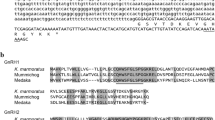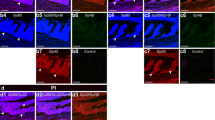Abstract
Aquaporins (AQPs) are a family of water channel proteins that play a major role in maintaining water homeostasis in various organisms. Several AQPs have been identified in the tree frog, Hyla japonica. Of these, AQP-h3BL, which is expressed in the basolateral membrane of the epithelial cells, is a homolog of mammalian AQP3. Using immunohistochemistry and in situ RT-PCR, we have demonstrated that AQP-h3BL is expressed in the anterior pituitary gonadotrophs of the tree frog but not in the other hormone-producing cells of the anterior pituitary. In gonadotrophs labeled for luteinizing hormone subunit-β (LHβ), AQP-h3BL protein was found to reside in the plasma membrane, the nuclear membrane and the cytoplasm. Double-labeling of AQP-h3BL mRNA and LHβ protein revealed that AQP-h3BL mRNA is expressed in the gonadotrophs. Following stimulation by gonadotropin-releasing hormone (GnRH), the label for AQP-h3BL localized in the plasma membrane became more intense, concomitant with the transport of LHβ-positive materials to the plasma membrane. These developments coincided with a decrease in the labeling density in the cytoplasm and near the nuclear membrane, suggesting that the latter localizations may function as “storage area“ for AQP-h3BL. Immunoelectron microscopy also confirmed these localizations of AQP-h3BL protein. Based on these results, we suggest that AQP-h3BL protein in the frog gonadotrophs is involved in the formation of secretory granules, the swelling and increase in the volume of the granules and exocytosis.






Similar content being viewed by others
References
Akabane G, Ogushi Y, Hasegawa T, Suzuki M, Tanaka S (2007) Gene cloning and expression of an aquaporin (AQP-h3BL) in the basolateral membrane of water-permeable epithelial cells in osmoregulatory organs of the tree frog. Am J Physiol Regul Integr Comp Physiol 292:R2340–R2351
Alvarez de Toledo G, Fernandez-Chacon R, Fernandez JM (1993) Release of secretory products during transient vesicle fusion. Nature 363:554–558
Arnaoutova I, Cawley NX, Patel N, Kim T, Rathod T, Loh YP (2008) Aquaporin 1 is important for maintaining secretory granule biogenesis in endocrine cells. Mol Endocrinol 22:1924–1934
Cho SJ, Sattar AK, Jeong EH, Satchi M, Cho JA, Dash S, Mayes MS, Stromer MH, Jena BP (2002) Aquaporin 1 regulates GTP-induced rapid gating of water in secretory vesicles. Proc Natl Acad Sci USA 99:4720–4724
Curran MJ, Brodwick MS (1991) Ionic control of the size of the vesicle matrix of beige mouse mast cells. J Gen Physiol 98:771–790
Fernandez JM, Villalon M, Verdugo P (1991) Reversible condensation of mast cell secretory products in vitro. Biophys J 59:1022–1027
Greer MA, Greer SE, Opsahl Z, McCafferty L, Maruta S (1983) Hyposmolar stimulation of in vitro pituitary secretion of luteinizing hormone: a potential clue to the secretory process. Endocrinology 113:1531–1533
Greer MA, Greer SE, Opsahl Z, Maruta S (1985) Comparison of hyposmolar and hyperosmolar effects on in vitro luteinizing hormone secretion by anterior pituitary cells. Proc Soc Exp Biol Med 178:24–28
Hasegawa T, Tanii H, Suzuki M, Tanaka S (2003) Regulation of water absorption in the frog skins by 2 vasotocin-dependent water-channel aquaporins, AQP-h2 and AQP-h3. Endocrinology 144:4087–4096
Hasegawa T, Suzuki M, Tanaka S (2005) Immunocytochemical studies on translocation of phosphorylated AQP-h2 protein in granular cells of the frog urinary bladder before and after stimulation with vasotocin. Cell Tissue Res 322:407–415
Ishibashi K, Kuwahara M, Sasaki S (2000) Molecular biology of aquaporins. Rev Physiol Biochem Pharmacol 141:1–32
Iwasawa A, Tanaka S, Hanaoka Y, Wakabayashi K (1992) Development and application of time-resolved fluoroimmunoassay for gonadotropin of a wide range of amphibian species. Zool Sci 9:175–183
Jena BP, Schneider SW, Geibel JP, Webster P, Oberleithner H, Sritharan KC (1997) Gi regulation of secretory vesicle swelling examined by atomic force microscopy. Proc Natl Acad Sci USA 94:13317–13322
Kano Y, Nakano T, Kumakura M, Wasa T, Suzuki M, Yamauchi K, Tanaka S (2005) Seasonal expression of LHβ and FSHβ in the male newt pituitary gonadotrophs. Gen Comp Endocrinol 141:248–258
Kato H, Kuwako K, Suzuki M, Tanaka S (2004) Gene expression patterns of pro-opiomelanocortin-processing enzymes PC1 and PC2 during postnatal development of rat corticotrophs. J Histochem Cytochem 52:943–957
Kelly ML, Cho WJ, Jeremic A, Abu-Hamdah R, Jena BP (2004) Vesicle swelling regulates content expulsion during secretion. Cell Biol Int 28:709–716
Kuwahara S, Maeda S, Tanaka K, Hayakawa T, Seki M (2007) Expression of aquaporin water channels in the rat pituitary gland. J Vet Med Sci 69:1175–1178
Matsuki M, Hashimoto S, Shimono M, Murakami M, Fujita-Yoshigaki J, Furuyama S, Sugiya H (2005) Involvement of aquaporin-5 water channel in osmoregulation in parotid secretory granules. J Membr Biol 203:119–126
Mizutani F, Iwasawa H, Tanaka S (1994) A morphometric analysis of the subcellular distribution of LHβ and FSHβ in secretory granules in the pituitary gonadotrophs of the frog (Rana japonica). Cell Tissue Res 277:417–426
Monck JR, Oberhauser AF, Alvarez de Toledo G, Fernandez JM (1991) Is swelling of the secretory granule matrix the force that dilates the exocytotic fusion pore? Biophys J 59:39–47
Nakakura T, Yoshida M, Dohra H, Suzuki M, Tanaka S (2006) Gene expression of vascular endothelial growth factor-A in the pituitary during formation of the vascular system in the hypothalamic-pituitary axis of the rat. Cell Tissue Res 324:87–95
Ogushi Y, Mochida H, Nakakura T, Suzuki M, Tanaka S (2007) Immunocytochemical and phylogenetic analyses of an arginine vasotocin-dependent aquaporin, AQP-h2K, specifically expressed in the kidney of the tree frog, Hyla japonica. Endocrinology 148:5891–5901
Park MK, Tanaka S, Hayashi H, Hanaoka Y, Wakabayashi K, Kurosumi K (1987) Production and characterization of a monoclonal antibody against the β-subunit of bullfrog lutropin. Gen Comp Endocrinol 68:82–90
Seale AP, Richman NH III, Hirano T, Cooke I, Grau EG (2003) Cell volume increase and extracellular Ca2+ are needed for hyposmotically induced prolactin release in tilapia. Am J Physiol Cell Physiol 284:C1280–C1289
Takata K, Matsuzaki T, Tajika Y (2004) Aquaporins: water channel proteins of the cell membrane. Prog Histochem Cytochem 39:1–83
Tanaka S, Nomizu M, Kurosumi K (1991) Intracellular sites of proteolytic processing of pro-opiomelanocortin in melanotrophs and corticotrophs in the rat pituitary. J Histochem Cytochem 39:809–821
Tanaka S, Mizutani F, Yamamoto K, Kikuyama S, Kurosumi K (1992) The alpha-subunit of glycoprotein hormones exists in the prolactin secretory granules of bullfrog (Rana catesbeiana) pituitary gland. Cell Tissue Res 267:223–231
Tanaka S, Yora T, Nakayama K, Inoue K, Kurosumi K (1997) Proteolytic processing of pro-opiomelanocortin occurs in acidifying secretory granules of AtT-20 cells. J Histochem Cytochem 45:425–436
Tanii H, Hasegawa T, Hirakawa N, Suzuki M, Tanaka S (2002) Molecular and cellular characterization of a water channel protein, AQP-h3, specifically expressed in the frog ventral skin. J Membr Biol 188:43–53
Watanabe S, Kaneko T, Aida K (2005) Aquaporin-3 expressed in the basolateral membrane of gill chloride cells in Mozambique tilapia Oreochromis mossambicus adapted to freshwater and seawater. J Exp Biol 208:2673–2682
Weber GM, Seale AP, Richman IN, Stetson MH, Hirano T, Grau EG, Leedom TA (2004) Hormone release is tied to changes in cell size in the osmoreceptive prolactin cell of a euryhaline teleost fish, the tilapia, Oreochromis mossambicus. Gen Comp Endocrinol 138:8–13
Acknowledgement
This investigation was supported in part by a grant-in–aid for scientific research from the Ministry of Education, Science, Sports, and Culture of Japan to S.T.
Author information
Authors and Affiliations
Corresponding author
Additional information
Megumi Sato and Takashi Nakakura contributed equally to this work
Rights and permissions
About this article
Cite this article
Sato, M., Nakakura, T., Ogushi, Y. et al. Expression of a mammalian aquaporin 3 homolog in the anterior pituitary gonadotrophs of the tree frog, Hyla japonica . Cell Tissue Res 343, 595–603 (2011). https://doi.org/10.1007/s00441-010-1122-1
Received:
Accepted:
Published:
Issue Date:
DOI: https://doi.org/10.1007/s00441-010-1122-1




